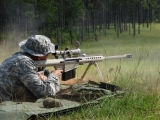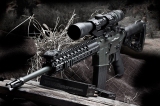- Posts: 195
- Thank you received: 0
The third wheel- how to correct for parallax.
- txlongshotb4
-
 Topic Author
Topic Author
- Offline
- Elite Member
-

Anyhow...
The third wheel that I reference here is more accurately the third knob, or dial, or turret, call it what you will. I am talking about the parallax knob on a rifle scope. In some models it can be located on the left-hand side of the turret housing, just hanging out with the windage and elevation knob. In some models it is actually a part of the objective lens housing. In some models, it is simply not present and the parallax must be corrected via the focus ring, which can become a daunting task. Almost every single scope that is designed to be used for long range will be equipped with some means to adjust parallax...there is a reason for this-because it's important!
I have spent a good amount of time coaching shooters in my lifetime...everywhere from the local 100 yard range with a .223 to the 1,780 tank hull target with a .50 cal. inevitably, someone will call me over, with frustration pouring from their ears, and tell me that no matter what they do, their shots are just all over the place. The me of long ago would have started going down the checklist...body position, stock weld, breathing, trigger squeeze, etc...but I have learned to ask one simple question first-"have you set your parallax to correspond to this range?"
I have learned to ask this question first, because nine times out of ten it is the culprit behind the issue. What surprises me however, are the responses I get to the question. There are a few guys who smack themselves upside the head and say "of course" and fix it themselves...but there are a lot more who look at me as if I have described an alien landscape they have never fathomed. Some folks just simply have never understood why that knob is there.
The scope manufacturers aren't helping us either by putting indicator marks on this dial to correspond to specific ranges-and they are really throwing a wrench in the gears when they put that little "infinity" symbol on there-the one that looks like a number 8 got kicked over and stomped on. Nine times out of ten, the pre set indicator marks do not actually correspond to the range, and there simply is no such thing as an infinity "one-size-fits-all" setting for parallax. A lot of guys respond to the question by saying "well I set it to infinity, so it should be good to go."
I'm not going to get into the textbook definitions of what parallax is...there are plenty of informative reads out there just waiting to be Googled. What I am going to do is try to explain parallax as it is relevant to us as shooters.Now for those of you reading this who are enlightened and know this subject like the back of your hand, read this and help me out if I stumble into some realm of mis information. I won't get into refraction and curvature distortion and all of that...I just want to help guys understand the theory of how that knob works and why it is critical-so this is going to be from the hip a bit.
Imagine the lenses of your scope-some models have almost a dozen of them in there. Most of them are put there for the sole purpose of magnifying an image downrange into a clear and crisp image on the lenses. At least one of them, however, projects the reticle of your scope onto this image. Understand here, that the lenses that project the reticle and the lenses that magnify and correct the image are not the same..they are two, separate mechanical devices that must be fine tuned and synchronized with each other in order to work together properly.
To put this into perspective, imagine standing in front of a large mirror. In both hands, held out in front of you at arm's length, is one bullet from your rifle-projectile end pointed straight up. Now stand facing straight-on into the mirror, and imagine that you are the target, and that bullet's tip is the point on your reticle where the vertical and horizontal stradia lines of the cross hairs meet-in other words,the aim point. Lock your elbows so that your arms are straight out, and manipulate your shoulders until that bullet is exactly where you would settle your cross hairs before pulling the trigger...establish that "sight picture" if you will. Once you are there, without moving your shoulders or elbows, pivot your feet a few degrees so that your hips turn ever so slightly in either direction. Notice what has happened to your reflection. Even though you have not changed your sight picture, your point of aim is now rather far from where it was before you turned.
Now return your body to face the mirror head on. Unlock your elbows, and bring the bullet into your body, until the projectile tip is touching your desired "point of aim". Once this is done, again pivot your feet and turn a few degrees away from the mirror. See what happened there? Regardless of the fact that you have shifted your angle, the point of aim has remained the same.
What you have demonstrated in this example is exactly like the relationship of your reticle to the image that your scope projects...you must manually put the reticle into the same focal plane as the projected image. If you do not do this, then you are the example of what happened when your arms were fully extended. If you do this correctly, then you are the example of when your arms were drawn in.
So here is how you correct your parallax...first off, make your weapon safe and clear. Then, you will need to rest the rifle by some means-be it a bi-pod and a sandbag under the stock,or cradled into a pack, what have you. You'll need to manipulate the rifle so that when it is no being touched, the scopes reticle is at least settled onto the paper of your target, or the backer board, or the berm directly behind it-just something within a foot or two of the target itself.
Now, get behind the gun, but do not touch it. back your eye off of the scope as far as you can and still maintain sight picture through it-be careful not to let your cheek touch the stock-and start to rotate your head in small circles as you look at the target through the scope. You will notice that as you do this, the target will remain still, and the cross-hairs will seem to track your head's movement, creating the illusion that they are rolling around in a circle on the target. This phenomenon you are seeing is uncorrected parallax. It is the same thing you saw when you turned your feet and changed your angle in the mirror when your arms were extended.
Stop and imagine what this effect does to accuracy. When the trigger breaks, recoil causes the whole body to move. When the sight picture is reacquired, we might have-and probably have-moved our head ever so slightly from where it was before...but we have no way of knowing, because the reticle is dancing around on the target due to uncorrected parallax...so we simply manipulate the rifle to index the reticle back to our desired point of aim, never even realizing that were are now chasing the "bobbing cross hairs" instead of aiming the rifle in the same place.
To correct this, we need to "draw the reticle in" to the image-much like we drew our arms into our body in the mirror- and put the reticle on the same focal plane as the image. This is done by simply turning the parallax knob on the scope, and repeating the process of rolling your head while looking through the scope until the reticle is stationary and fixed on a point inside of the target image. This must be done at EVERY range you intend to shoot...the parallax adjustment for 100 yards will not be the same for 125 yards or 75 yards.
It might be worthy of note here-it is VERY difficult to get the reticle set perfectly into the focal plane of the image...for all I know, it might just be impossible...I cannot say I can ever recall getting it perfect...but the point is, the closer you get it to being perfect, the tighter your shot groups will be-provided you are doing everything else correctly. Correcting your parallax will certainly give you better results at the 100 yard range-and it is an absolute must if you plan to hit anything at long range.
Worthy of note-it might be a good idea to keep some sort of a scribe or a paint marker in your range bag, and once you've found your "sweet spot" for parallax at a given range, make some sort of mark on the dial so that you can return to that index quickly at a later date...but if it's a REALLY long shot, always take the time to re-check it...it could be the difference between the win or the loss-and depending on what game you are playing, a loss can really, really suck.
So that's my advice for today...That knob hanging out over there on the other side of the scope is there for a reason-a very good one-don't forget about it when the time comes!
Please Log in or Create an account to join the conversation.
Please Log in or Create an account to join the conversation.
Please Log in or Create an account to join the conversation.
Please Log in or Create an account to join the conversation.
Please Log in or Create an account to join the conversation.
- Libertarian623
-

- Offline
- Platinum Member
-

- Posts: 880
- Thank you received: 0
Please Log in or Create an account to join the conversation.
Please Log in or Create an account to join the conversation.
Please Log in or Create an account to join the conversation.
Please Log in or Create an account to join the conversation.
- NightForce
-

- Offline
- Platinum Member
-

- Posts: 942
- Thank you received: 0
Please Log in or Create an account to join the conversation.
All content of this site is copyright 2003 - 2017
AR-10(T)™, AR-10™, are trademarks of ArmaLite, Inc.®
AR10T.com is NOT endorsed or affiliated with ArmaLite, Inc.®
